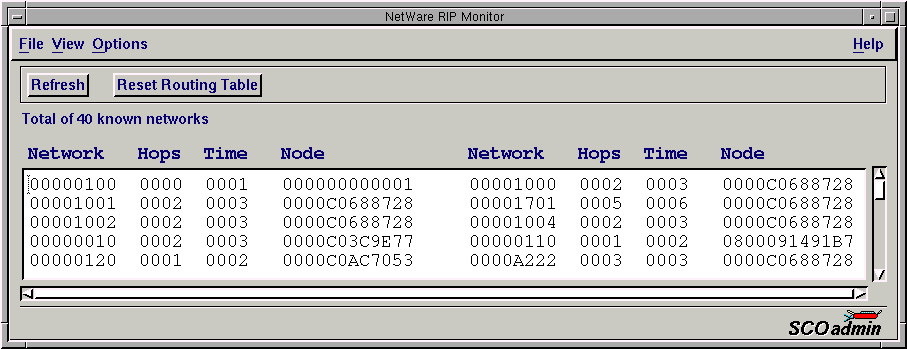
|
|
All hosts that are capable of acting as NetWare routers maintain a routing information table. This allows the routers to forward packets by the best possible route. SCO IPX/SPX can be configured to act as a router , and thus all SCO IPX/SPX servers maintain a routing information table. For more information about the routing information table, see ``Packet delivery''. For more information about configuring an SCO OpenServer system as a router, see NPSConfig(SFF) for more information.
In a NetWare network, routers periodically emit broadcasts containing their routing information tables, as specified by the NetWare RIP (Routing Information Protocol) standard.
The NetWare RIP Monitor and its command-line alternatives, drouter(PADM) and rrouter(PADM), display the current routing information tables and allow the superuser to reset and update the routing tables. Both of these features can be used to highlight potential problems in a network's configuration.
A useful feature of the NetWare RIP Monitor is automatic screen refresh which updates the routing information display at a regular, user-specified interval. The refresh interval can be controlled using a slider for the amount of time in minutes and seconds between refreshes. Automatic screen refresh can be set using the Set Auto Refresh cascade menu, which is available under the View menu.
If information about known nodes is missing from the routing information table, then there may be problems with the routing information broadcasts. See ``Router operation'' for procedures to remedy this situation.
The NetWare RIP Monitor's output looks like this:

The NetWare RIP Monitor displays the following:
Using this information, it is possible to detect the following situations:
One of the most common errors when adding a host to a network is choosing an internal network number or network number that is not unique. If you have a situation where a host is visible to only a portion of your network, it is likely that the network number(s) have been misconfigured. In this case, compare the output from the NetWare RIP Monitor on a number of different hosts on your network. You should be able to trace the same path to the new host from all the different hosts on your network. This is possible because the network and node number information in the routing information table will either be that of a router, the local host, a host on the network, or the network the host is connected to.
From the command line, a combination of rrouter and drouter can monitor the operation of routing information broadcasts: rrouter clears and updates the routing information table. A command-line user can periodically run drouter to monitor the status of the routing information table as it is updated by routing information broadcasts, updating the tables with rrouter if required.